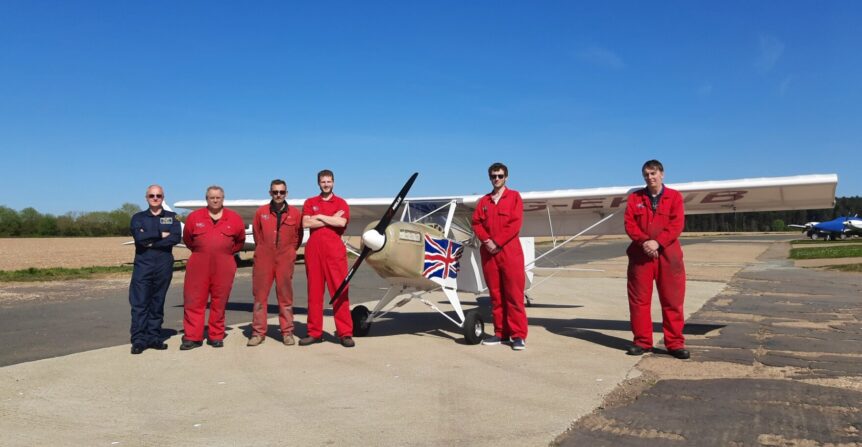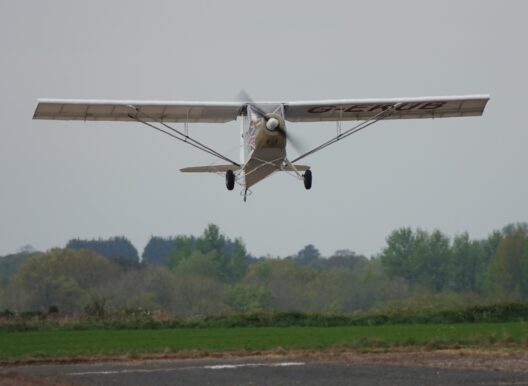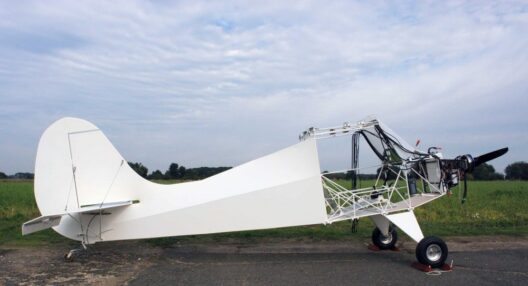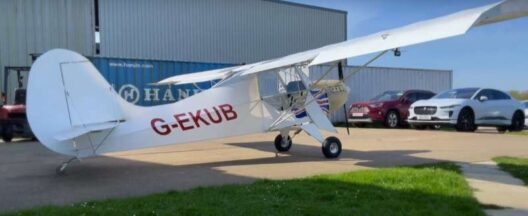A Proper British Aeroplane
eKub is the latest offering from The Light Aircraft Company (TLAC), a British company that specializes in modern adaptations of classic-themed flying machines. At nearby Cranfield University, Dr Guy Gratton, Associate Professor of Aviation and the Environment, teaches and acts as test pilot on the eKub. Gratton is also an Associate Fellow of the Society of Experimental Test Pilots.
TechXplor reports, “After taxi tests and “low hops,” the single seat Sherwood eKub made its first flight of 10 minutes and then a second flight later in the day of 22 minutes from Little Snoring airfield in Norfolk.”
He can’t seem to get enough of the little ultralight single seater, posting a Tweet showing his takeoff in G-EKUB. He reports, “Back in the electric office today, more lessons learned, more progress towards practical and viable electric aeroplanes.” In response to a reader’s question about battery limits on flight time, he explains, “Looking increasingly that we’ll hit our design target of about 10-15mins taxi, 50-55mins airborne, 20+ minutes reserves.”
Dr. Gratton is highly appreciative of the little “aeroplane.”
“The aeroplane flew very much as predicted from our analysis and ground tests; this is a new way of flying, and we’re at the start of a steep learning curve on electric flight.
“The support from everybody on the team, as well as colleagues, funders and authorities has been fantastic in making this possible.
“As a test pilot, an aeronautical engineer, and as a researcher, learning all about this new class of aeroplane is one of the most exciting things I’ve ever done.”
Ultralight Kits on the Way?
ITV reports TLAC built the aircraft based on the standard Sherwood KUB kit. Paul Hendry-Smith, a company Director, explains that the eKub “is currently being built as a prototype working within a consortium of other organizations under the ‘EnabEl project’ (Enabling Aircraft Electrification) which falls within the Innovate UK future flight challenge.
Flyer reports, “However, the intention is to roll it out as a commercially available aircraft both in self build kit form and as a factory build option.” eKUB would have several advantages over more conventional ultralights, including:
- Zero emissions
- Virtually silent flight
- Easy charging with the potential of using solar energy
- A projected 1 hour flight time (with an additional 15 minute reserve) on a full charge.
The TLAC team modified a standard KUB kit, including, “Control panel design and modification, finalizing throttle mechanism design and installation, tubular motor mount design and reconfiguration to hold the main battery and the battery controller, and CNC [machining of] the motor mount block.” TLAC modified cowlings (normally enclosing two-stroke engines up to 50 hp.) and waits for more flight tests to see how the design manages vibration and other stresses. The team modified the landing gear, tail feathers and designed and installed battery boxes in the wings.
They finished by covering the aircraft in Oratex 600 fabric, a product TLAC sells. Embellished with a British flag, the little craft looks quite fetching.
British ultralight rules allow for a single-seat de-regulated (SSDR) category. A pilot with a Microlight license (something close to an FAA Sport Pilot license), a medical certificate (which can be self-declared) and insurance can pilot the craft, which must weigh no more than 300 kilograms (660 pounds) total, although allowances are made for a ballistic recovery parachute and flotation devices. The airplane must have a stall speed of 35 knots calibrated airspeed (40 mph or 65 kilometers per hour).
Some Tips from the Test Pilot
Dr. Gratton had some thoughts following his initial flights, probably of interest to others wondering how to make the transition to electric power.
“Whilst not silent, vibration is very low and mostly from the propeller (despite this aircraft actually having no anti-vibration mounting on the main motor). Interestingly what vibration we get is least at highest flight speeds – don’t understand that yet.
“Thrust available shouldn’t vary much with height (that’s the theory anyhow, but I need to get somewhat above 2,000ft to prove that!), but it does depend upon battery state of charge (SoC) – ground tests indicate that a full cold battery will have about 20% more power available than a warm nearly flat battery.
“A parameter I’ve been calling TAFT (Time at Full Throttle) matters a lot, due to a combination of factors. Power available drops off the longer you’ve been at full throttle. In ground test that was by around 10%/minute, although in flight test, most likely due to better forced cooling, nearer 3-4%/minute, which is more acceptable.”
Part of a Bigger Scheme
Cranfield University explains the larger scheme of which eKUB is a beginning. “Funded by consortium partners and UK Research and Innovation (UKRI) as part of the Future Flight Challenge (FFC) initiative, the eKub is part of the broader EnabEl project focused on delivering safe, viable, and environmentally–efficient aeroplanes.”
The government is investing up to £125 million “to develop greener ways to fly,” with private industry adding up to £175 million for electric flight, drone deliveries, and automated systems. Hoped-for outcomes will:
- create the aviation system of the future
- increase mobility, improve connectivity and reduce congestion for people across the UK
- advance electric and autonomous flight technologies to help the UK reach its net zero target
- drive technology investment to the UK by increasing UK manufacturing and service opportunities.
eKUB may seem like a simple conversion of an existing ultralight aircraft, but it’s been done with intelligence and care. It’s also a first draft of a larger plan, with a two-seat microlight following close behind, and lessons learned sure to nurture more complex projects to come. Long may this union jack fly.





Comments 2
Any actual flight data? Power, energy, battery consumption, etc…
Author
Not yet. The video indicates ultralight performance, and the initial conclusion by Dr. Gratton show an hour plus reserve duration. Your editor is anxious to see where this goes.